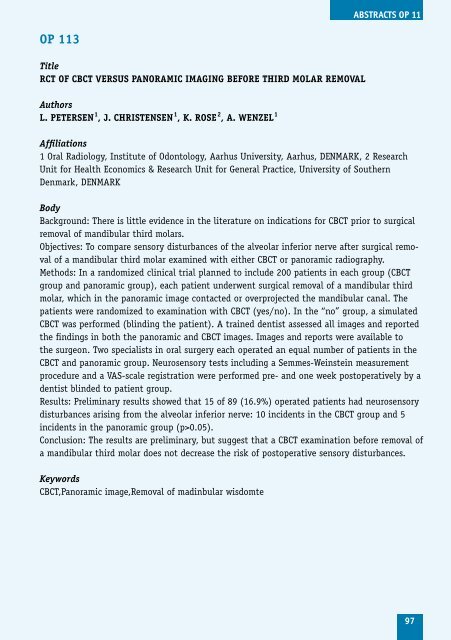Program including abstracts as pdf available here
Program including abstracts as pdf available here
Program including abstracts as pdf available here
You also want an ePaper? Increase the reach of your titles
YUMPU automatically turns print PDFs into web optimized ePapers that Google loves.
OP 113<br />
Title<br />
RCT OF CbCT VERSuS PANORAMIC IMAGING bEFORE THIRD MOLAR REMOVAL<br />
Authors<br />
L. PETERSEN 1 , J. CHRISTENSEN 1 , K. ROSE 2 , A. WENzEL 1<br />
aBSTracTS OP 11<br />
Affiliations<br />
1 Oral Radiology, Institute of Odontology, Aarhus University, Aarhus, DENMARK, 2 Research<br />
Unit for Health Economics & Research Unit for General Practice, University of Southern<br />
Denmark, DENMARK<br />
Body<br />
Background: T<strong>here</strong> is little evidence in the literature on indications for CBCT prior to surgical<br />
removal of mandibular third molars.<br />
Objectives: To compare sensory disturbances of the alveolar inferior nerve after surgical removal<br />
of a mandibular third molar examined with either CBCT or panoramic radiography.<br />
Methods: In a randomized clinical trial planned to include 200 patients in each group (CBCT<br />
group and panoramic group), each patient underwent surgical removal of a mandibular third<br />
molar, which in the panoramic image contacted or overprojected the mandibular canal. The<br />
patients were randomized to examination with CBCT (yes/no). In the “no” group, a simulated<br />
CBCT w<strong>as</strong> performed (blinding the patient). A trained dentist <strong>as</strong>sessed all images and reported<br />
the findings in both the panoramic and CBCT images. Images and reports were <strong>available</strong> to<br />
the surgeon. Two specialists in oral surgery each operated an equal number of patients in the<br />
CBCT and panoramic group. Neurosensory tests <strong>including</strong> a Semmes-Weinstein me<strong>as</strong>urement<br />
procedure and a VAS-scale registration were performed pre- and one week postoperatively by a<br />
dentist blinded to patient group.<br />
Results: Preliminary results showed that 15 of 89 (16.9%) operated patients had neurosensory<br />
disturbances arising from the alveolar inferior nerve: 10 incidents in the CBCT group and 5<br />
incidents in the panoramic group (p>0.05).<br />
Conclusion: The results are preliminary, but suggest that a CBCT examination before removal of<br />
a mandibular third molar does not decre<strong>as</strong>e the risk of postoperative sensory disturbances.<br />
Keywords<br />
CBCT,Panoramic image,Removal of madinbular wisdomte<br />
97


